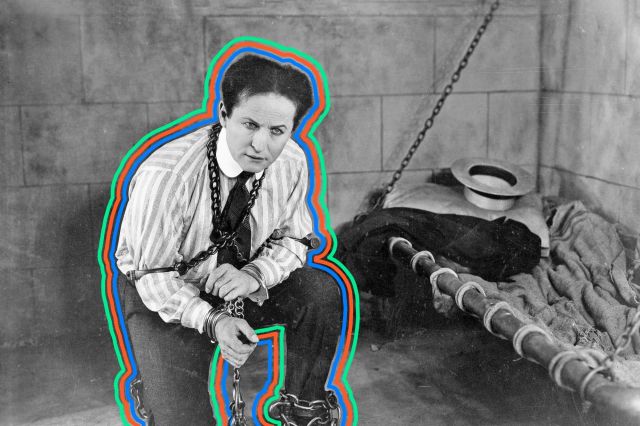
Houdini Was Inspired by the “Father of Modern Magic”
According to the researcher John Cox, Houdini’s beginnings as a serious stage artist can be traced to his discovery of Frenchman Jean-Eugène Robert-Houdin, the “father of modern magic.” After reading Robert-Houdin’s memoir in 1891, the New York City teen — then known as Ehrich Weiss — quit his job as a tie-cutter, changed his name to Harry Houdini, and set his legendary career in motion. However, his eventual mastery of stagecraft seemingly soured Houdini on the tricks of his predecessor, and in 1908, he bluntly denounced the methods of his erstwhile hero with the publication of The Unmasking of Robert-Houdin.

Houdini’s Performances Were a Family Affair
Although Houdini is largely remembered as a one-man show, a couple of loved ones were prominently involved in his performances. He shared the stage with his younger brother Theo in the early 1890s and later helped establish Theo as a rival illusionist and escape artist named Hardeen, with their manufactured “bad blood” providing extra publicity for their dueling performances.
Houdini spent even more time working with his wife, Bess, who faithfully served at his side after taking over for Theo in 1894. Although she reportedly retired in 1908, Bess occasionally rejoined her husband on stage, and once again became a trusted partner by the time he launched his late-career 3 Shows in One act.

Houdini’s “Mirror” Handcuffs Challenge Cemented His Fame
The performance that solidified Houdini’s iconic status took place in March 1904, when the “Handcuff King” agreed to a challenge from the London Daily Mirror which placed him in a pair of special cuffs that allegedly took five years to construct and “could not be picked.” Working his magic from behind a curtain, an exasperated Houdini appeared at one point to stretch, get a glass of water from Bess, and accept a cushion. He later dramatically slashed off his coat with a penknife and emerged triumphant after more than an hour’s struggle. As with many of Houdini’s tricks, the secret to this famous escape went to the grave with its master, although some have speculated that he simply used a key that was passed along in the cushion or glass of water.
More Interesting Reads

Houdini Once Dazzled Teddy Roosevelt
While Houdini could command crowds of 10,000 spectators for his outdoor shows, he likely got one of his biggest kicks from a semi-private performance for Theodore Roosevelt aboard the SS Imperator in June 1914. The illusionist employed a slate trick, a common practice among mediums at the time, where the participant writes down a question and then a “spirit” answers it. Houdini had Roosevelt write down a question, “Where was I last Christmas?” and then placed it between the pages of a book. The book was then reopened to reveal a map of South America and details of the former President’s then-unknown trip to a tributary of the Amazon River. Houdini reassured his stunned audience that he wasn’t really communicating with spirits, though he declined to admit that he’d learned of Roosevelt’s expedition from editorial friends at the U.K.’s Telegraph, and then used his sleight-of-hand skills to slip the map into the book.

Houdini’s Screen Career Flopped
After years of filming his performances, Houdini went all-in on the burgeoning motion-picture industry as he entered his 40s. He starred in the 15-part serial The Master Mystery (1918) and a pair of feature films, and by 1921, he had also launched an interrelated web of companies to produce, develop, and distribute movies. But while audiences loved his live shows, Houdini failed to find the magic formula with his big-screen offerings, which typically showcased him escaping hairy situations set up by the action-romance script. After The Man From Beyond (1922) and Haldane of the Secret Service (1923) bombed, Houdini abandoned his Hollywood hopes and returned to his tried-and-true methods of entertainment.

Houdini Almost Died While Being Buried Alive
Houdini’s death-defying stunts occasionally veered off their carefully planned paths, and while the story that he got trapped beneath a frozen river may have ultimately been a fabrication, an attempt at a “buried alive” trick nearly took his life. According to Cox, the incident likely happened when Houdini, preparing for a show in the Los Angeles area in spring 1919, did a test run of being handcuffed and buried beneath six feet of soil. The earth proved weightier than expected, however, and after his cries for help went unnoticed, the almost-suffocated showman managed to dig his way to the surface. Houdini later referred to it in an article for Collier’s as “the narrowest squeak of my life.”

Houdini Was Anti-Spiritualist But Also Believed in Communicating With the Dead
Few public figures were more vocal than Houdini when it came to opposing the Spiritualist movement that gained steam in Western culture after World War I. He feuded with Sir Arthur Conan Doyle on the topic, undertook a lecture tour to expose the methods employed by mediums, and even testified in congressional hearings about a proposed bill to regulate the fortune-telling business. Yet for all his skepticism, Houdini remained intrigued by reincarnation and the possibilities of communicating with the dead. He and his wife agreed to try to contact one another should death pull them apart, a pact faithfully followed by Bess for a full decade following Houdini’s passing on Halloween 1926. As far as we know, there was no evidence of contact.












